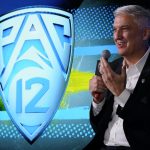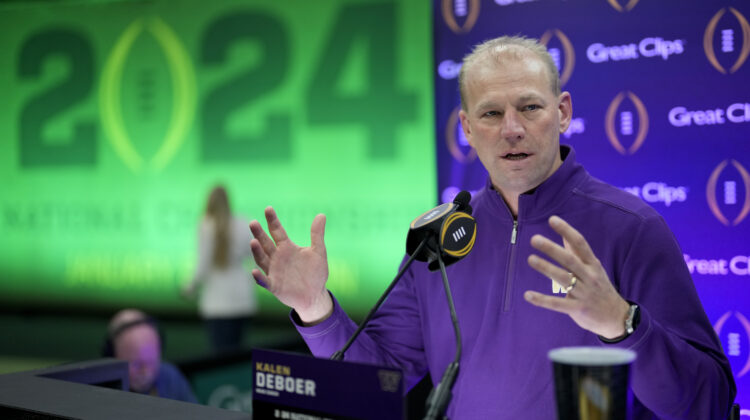Is Washington a flash in the pan or a future problem? Given all the players with expiring eligibility, including quarterback Michael Penix Jr., I don’t see how the Huskies won’t fall back to middle of the pack next year. — @joelhecker
That depends entirely on your standard for comparison.
Will the Huskies prove to be a “flash in the pan” compared to the level of success achieved by Alabama, Georgia and Ohio State? Probably.
But will they be a “flash” compared to everyone else? Unlikely.
Only seven schools have made multiple appearances in the College Football Playoff over its 10-year existence: Alabama (seven), Clemson (five), Ohio State (five), Georgia (three), Michigan (three), Oklahoma (three) and Washington (two).
 Add the Rose Bowl (2018 season) to their playoff appearances (2016 and 2023), and the Huskies have participated in the prestigious New Year’s Six lineup of games three times in 10 years. Not many schools have done that, either.
Add the Rose Bowl (2018 season) to their playoff appearances (2016 and 2023), and the Huskies have participated in the prestigious New Year’s Six lineup of games three times in 10 years. Not many schools have done that, either.
As long as Kalen DeBoer is leading the program — his contract situation is a topic for another column — the Huskies will be competitive at the highest level.
Could they regress next season? Of course. The Huskies needed a slew of narrow escapes just to reach this point. Had two or three plays turned out differently, they never would have made the playoff.
And that’s all with Penix performing at the highest level.
Then again, expansion of the playoff field next season will create more margin for error. UW won’t need a 13-0 or 12-1 record to make the 12-team event. There will be participants with multiple losses.
In our view, Washington’s primary challenges moving forward are internal: Will the school provide DeBoer with the resources to keep his coaching staff together? Will the Huskies continue to remain competitive in the NIL market for elite recruits?
After all, Washington and Oregon are entering the Big Ten with half-shares of the conference’s media rights revenue. That translates to a $30 million (approximate) annual deficit relative to the likes of Ohio State, Michigan, Penn State and USC.
But for the financial piece, the Hotline would expect the Huskies to compete for a playoff berth each season in the Big Ten. Everything else is in place — well, everything except DeBoer’s contract.
Consistent success at the highest level of the sport depends on adequate resources, and UW is facing an unusual challenge on the revenue front. That cannot be ignored.
What happens to Stanford and Cal should ESPN decline to exercise its 2027 option to extend its TV contract with the ACC to 2036? — @TerryTerry79
There are several potential outcomes for the Bay Area schools, and they depend largely on the result of Florida State’s legal challenge to the ACC’s grant-of-rights contract.
If the Seminoles are successful in breaking the agreement and enough schools follow them out the door, then ESPN might not have the chance to exercise (or decline) its 2027 option. The conference could fracture before then.
And if what remains is deemed unacceptable by ESPN, prompting the network to terminate the media rights contract, then Stanford and Cal would, like everyone else, become free agents.
At that point, it’s anyone’s guess where they would land.
Perhaps they remain in a restructured conference based on the Atlantic Seaboard.
Perhaps they join the Big Ten to create a six-team Western division with USC, UCLA, Oregon and Washington.
Perhaps they rejoin Oregon State and Washington State in a Pac-4, which eventually becomes a Pac-8 or Pac-10 with other additions.
It’s all conjecture, but this much is clear: Given the instability in the ACC and the highly fluid landscape of college football, the Bay Area schools took a massive risk by locking themselves into their new home until 2036.
Because it’s entirely possible that the top football schools will depart, leaving Stanford and Cal bound to a greatly depleted conference based 3,000 miles from their campuses.
How will the ‘Pac-2’ approach rebuilding the conference? — @CFTmoment
Now that Washington State and Oregon State have settled the lawsuit, gained control of Pac–12 assets and established a plan to share the liabilities with the outgoing schools, they can move forward.
Remember, NCAA rules provide them with a two-year grace period to compete as a two-team league.
The most pressing issue, securing competition schedules, already has been addressed through agreements with the Mountain West (football) and West Coast Conference (basketball and Olympic sports).
As a result, the schools have time to plot their strategy. In fact, the Cougars and Beavers would be wise to remain as flexible as possible, for options might exist starting in 2026 that are not currently visible. If the ACC fractures, for example, another round of realignment could begin.
One issue the ‘Pac-2’ will address sooner than later: The future of commissioner George Kliavkoff. We expect him to be dismissed, either with his full buyout or through a mediated settlement.
Now that the ‘Pac-2’ schools have settled the lawsuit with the ‘Traitorous 10’, what will become of the Pac–12 Networks broadcasting WSU and OSU football and basketball in 2024 and beyond? — Gary Cox
The Pac–12 Networks will cease to exist as a media distribution company next summer. The contracts with Comcast, Dish and others expire and won’t be renewed.
However, the Pac–12 Networks production studio in San Ramon, California, features cutting-edge technology and could be of value (through a sale or lease) to a media company for streaming purposes.
Our suspicion is that WSU and OSU will sell the rights to their football and basketball games to an established distributor for pennies on the dollar for the next two years, and that’s fine: In the short term, the schools need exposure more than they need cash.
Once 2026 arrives, everything changes. The Pac–12 Networks’ technology could be part of a reconfigured conference.
What is going to happen in the future at the Rose Bowl in a non-playoff year? I don’t think anyone will want to watch a fifth-place Big Ten team play a ‘Pac-2’ team. — Michael Miller
The Rose Bowl will be part of the expanded CFP every year, along with the Fiesta, Sugar, Cotton, Peach and Orange Bowls.
For the next two seasons, the Granddaddy will host a quarterfinal matchup on Jan. 1. And while the schedule hasn’t been set for 2026 season and beyond, we assume that rotation will continue: Two out of every three years, the Rose Bowl will host a quarterfinal on Jan. 1; in the third year, it will host a semifinal matchup on Jan. 8 or 9.
The lingering question is whether the Rose will attempt to stage a second bowl game (on New Year’s Day) in the years it’s scheduled to host a semifinal the following week.
Like so much else about the playoff in 2026 and beyond, that piece is uncertain.
The first round games for the 2024 playoff will take place on December 20-21, with teams ranked 5-12 participating. Will the losers be eligible to participate in a bowl game? I would think that a team ranked 5-12 would be attractive options. — Wayne Niebroski
We are not aware of any rule forbidding opening-round CFP losers from playing in a bowl game seven or eight days later. However, it seems unlikely for a variety of reasons.
To name one: The bowl game would not know the identity of its participant until a week before the game and therefore could not market the matchup.
Also, would any fans spend a dime to travel to the bowl game after a deflating playoff loss? Probably not.
And what about the players? Would they be interested in gearing back up for what would be a meaningless game?
There are other obstacles. But generally speaking, we like your outside-the-box thinking.
From a value-add perspective, how would you rate the Pac–12 schools’ basketball additions to their respective new conferences? — @Cargoman0363
First, let’s remind readers that football accounts for roughly 80 cents of every $1 spent on conference media rights; the rest goes to basketball.
Viewed from that perspective, none of the Pac–12 basketball programs will drive significant revenue for their new conferences.
However, Arizona and UCLA should bring a degree of value to the Big 12 and Big Ten, respectively. The two programs have the brand strength to create more high-level matchups for their leagues. (For instance, Big 12 basketball inventory will feature at least one Arizona-Kansas game per season.)
That said, conference realignment continues to be defined by football.
Do you think Pac–12 commissioner George Kliavkoff should write a book to get his story out for public consumption? — @mlondo856
The Hotline is well aware of Kliavkoff’s hesitancy to provide in-depth comments about the failed media rights saga while he’s employed by the conference.
But once the terms of his buyout are set — and unless there’s some form of a non-disclosure agreement — then he owes a full accounting of the situation to Pac–12 fans and the schools themselves.
Kliavkoff has claimed privately that the version of events documented by the media (here and elsewhere) is missing key facts. And his public comments earlier this week certainly indicate he has a story to tell — a story that paints him in favorable terms and places blame entirely on the schools for not being “more patient” with a process that lasted 13 months.
Will he ever speak frankly about the media rights negotiations? Will he eventually accept responsibility or express regret? We’re skeptical.
Related posts:
 Wilner – Presidential Power Index: Ranking the Pac-12 presidents based on boardroom influence
Wilner – Presidential Power Index: Ranking the Pac-12 presidents based on boardroom influence 
(AP Photo/Marcio Jose Sanchez)
Who’s in charge of the Pac-12? Answer unclear as the lawyers dig in
(AP Photo/Marcio Jose Sanchez)
Mailbag: Kliavkoff’s current role and final grade, options for the ‘Pac-4’ schools, the Knight view and a few words on our coverage
(AP Photo/Ralph Freso, File)
What’s next for the ‘Pac-2’: Could Washington State, Oregon State attempt a reverse merger with the Mountain West?
